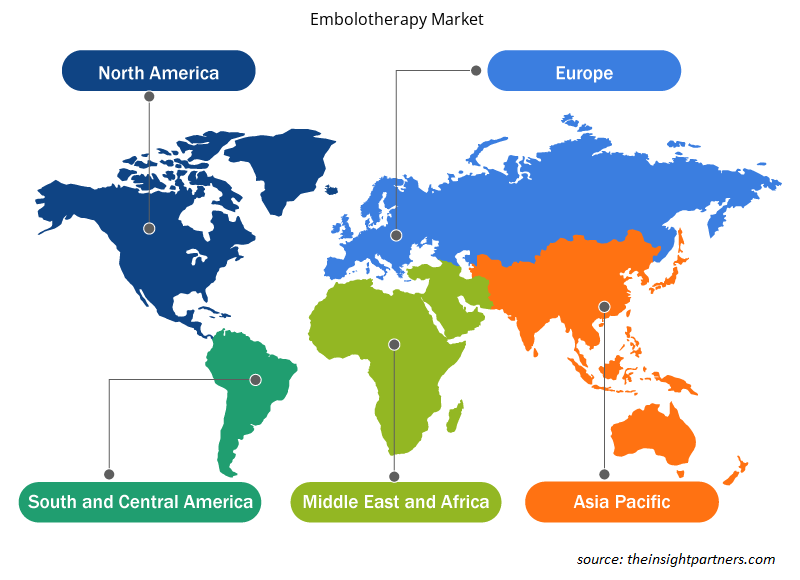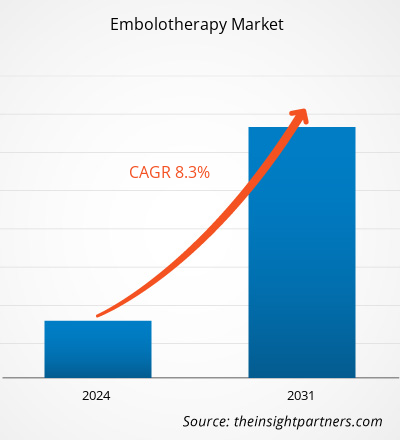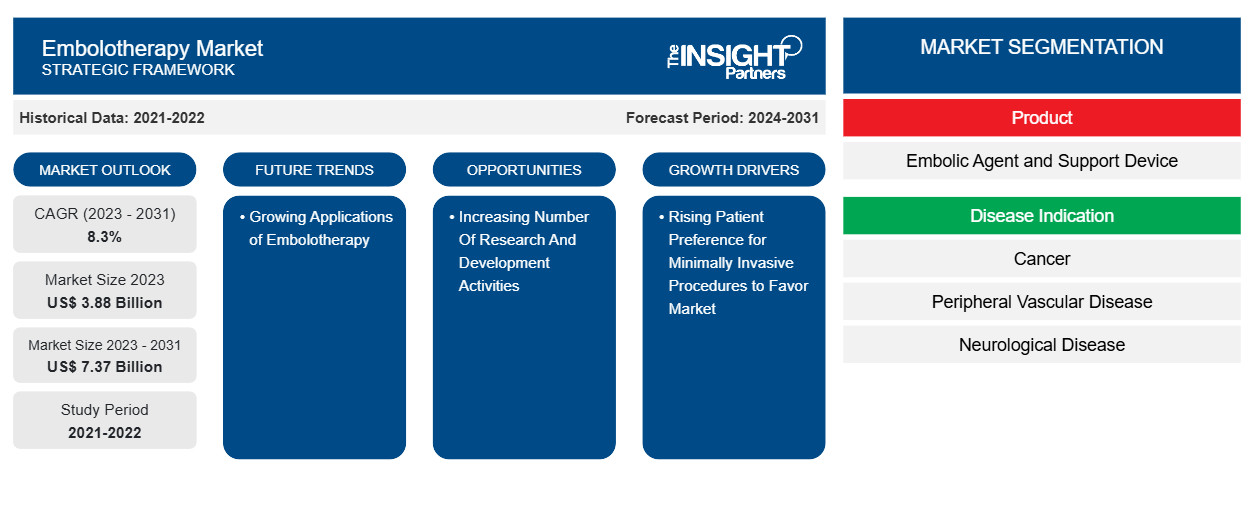Le marché de l'embolisation devrait atteindre 7,37 milliards USD d'ici 2031, contre 3,88 milliards USD en 2023. Le marché devrait enregistrer un TCAC de 8,3 % au cours de la période 2023-2031. L'utilisation croissante d'agents emboliques liquides devrait rester une tendance clé du marché.
Analyse du marché de l'embolisation
L’incidence croissante des accidents vasculaires cérébraux et des anévrismes a été observée en Europe et dans le monde. Par exemple, en Espagne, l’accident vasculaire cérébral est considéré comme la troisième cause de décès après la maladie d’Alzheimer et l’accident vasculaire cérébral ischémique. De plus, en Afrique, l’hypertension est le principal facteur de risque d’accident vasculaire cérébral, aux côtés d’autres facteurs de risque tels que l’obésité, le stress, le tabagisme, la consommation d’alcool, l’inactivité physique et une alimentation malsaine. En outre, en 2020, 111 321 nouveaux cas de cancer ont été diagnostiqués en Afrique du Sud, avec plus de 64 547 décès liés au cancer dans le pays. En raison des facteurs susmentionnés, de nombreuses organisations mettent en œuvre des programmes visant à réduire la mortalité due aux maladies chroniques . Par exemple, le programme Healthy Heart Africa (HHA) a été lancé par AstraZeneca pour prévenir l’hypertension et réduire le fardeau croissant des maladies cardiovasculaires en Afrique.
Aperçu du marché de l'embolisation
L'utilisation croissante de l'embolisation dans le traitement des maladies endovasculaires, des lésions traumatiques, des malformations cérébrovasculaires, des malformations veineuses, des malformations artérioveineuses et des affections vasculaires pédiatriques devrait offrir une opportunité de croissance des revenus du marché de l'embolisation au cours des prochaines années. La prévalence des anévrismes cérébraux au Canada est en hausse. Selon la Brain Aneurysm Foundation, environ 2 800 à 3 500 personnes souffrent d'un anévrisme cérébral chaque année, ce qui représente environ 3 % de tous les accidents vasculaires cérébraux hémorragiques. De plus, la prévalence est observée chez les personnes âgées de plus de 40 ans. Selon l'Institut canadien d'information sur la santé, au cours des 20 prochaines années, la population âgée de 65 ans devrait augmenter de 68 %. Selon la Brain Injury Association, environ 160 000 Canadiens subissent une lésion cérébrale acquise chaque année. Ces taux continuent d'augmenter et sont susceptibles d'augmenter les risques d'anévrisme.
Personnalisez ce rapport en fonction de vos besoins
Vous bénéficierez d'une personnalisation gratuite de n'importe quel rapport, y compris de certaines parties de ce rapport, d'une analyse au niveau des pays, d'un pack de données Excel, ainsi que de superbes offres et réductions pour les start-ups et les universités.
- Obtenez les principales tendances clés du marché de ce rapport.Cet échantillon GRATUIT comprendra une analyse de données, allant des tendances du marché aux estimations et prévisions.
Facteurs moteurs et opportunités du marché de l'embolisation
La préférence croissante des patients pour les procédures mini-invasives favorise le marché
La préférence s'est déplacée de la chirurgie ouverte vers des procédures mini-invasives avec imagerie en temps réel. L'embolisation de l'artère prostatique (EAP) est également une thérapie mini-invasive mise en œuvre comme technique ambulatoire élective pour les symptômes des voies urinaires inférieures (SVUI) secondaires à une hyperplasie bénigne de la prostate (HBP). Le nombre total de patients guéris grâce à l'EAP a augmenté ces dernières années. L'embolisation s'est imposée comme une technique mini-invasive pour obtenir une occlusion vasculaire . Les agents emboliques liquides ont attiré une attention considérable car ils pénètrent profondément dans les vaisseaux et indépendamment de la formation de thrombus, qui dépend du système de coagulation du patient.
Augmentation du nombre d'activités de recherche et développement
En raison de l'augmentation des activités de recherche et développement, de nouvelles introductions et innovations devraient favoriser l'adoption de nouvelles technologies, propulsant ainsi la croissance du marché. Par exemple, en septembre 2021, le ministère coréen de la sécurité alimentaire et pharmaceutique (MFDS) a approuvé le système d'embolisation par bobine NUMEN et le système de détachement NUMEN FR de MicroPort NeuroTech. Pour une utilisation hospitalière, NUMEN est principalement utilisé dans les procédures d'enroulement endovasculaire pour traiter les anévrismes intracrâniens en raison de son embolisation stable et de son emballage dense. En outre, ils ont également développé de manière dépendante le système d'embolisation par bobine NUMEN, qui a été approuvé par le service coréen d'examen et d'évaluation de l'assurance maladie (HIRA) en tant que produit éligible au remboursement de l'assurance maladie en Corée. Les facteurs ci-dessus créeront probablement des opportunités pour le marché de l'embolisation au cours de la période de prévision.
Analyse de segmentation du rapport sur le marché de l'embolisation
Les segments clés qui ont contribué à l’élaboration de l’analyse du marché de l’embolisation sont le produit, l’indication de la maladie, la procédure et l’utilisateur final.
- En fonction du produit, le marché de l'embolisation est divisé en agents emboliques et dispositifs de soutien. En outre, le segment des agents emboliques est sous-segmenté en microsphères, bobines emboliques, agents emboliques liquides, systèmes de bouchons emboliques, ballons détachables et autres. En outre, le segment des dispositifs de soutien est encore divisé en microcathéters et fils-guides. Le segment des agents emboliques détenait une part de marché plus importante en 2023.
- En fonction des indications de la maladie, le marché de l'embolisation est divisé en cancer, maladies vasculaires périphériques, maladies neurologiques, troubles urologiques et néphrologiques, troubles gastro-intestinaux et autres. Le segment du cancer détenait une part de marché plus importante en 2023.
- En fonction de la procédure, le marché de l'embolisation est divisé en embolisation artérielle transcathéter (TAE), radioembolisation artérielle transcathéter (TARE)/radiothérapie interne sélective (SIRT) et chimioembolisation transartérielle (TACE). Le segment de l'embolisation artérielle transcathéter (TAE) détenait une part de marché plus importante en 2023.
- En fonction de l'utilisateur final, le marché de l'embolisation est divisé en hôpitaux et cliniques, centres de chirurgie ambulatoire et autres utilisateurs finaux. Le segment des hôpitaux et des cliniques détenait une part de marché plus importante en 2023.
Analyse des parts de marché de l'embolisation par zone géographique
La portée géographique du rapport sur le marché de l’embolisation est principalement divisée en cinq régions : Amérique du Nord, Asie-Pacifique, Europe, Moyen-Orient et Afrique, et Amérique du Sud et centrale.
L'Amérique du Nord a dominé le marché et l'Asie-Pacifique devrait connaître le TCAC le plus élevé dans les années à venir. La croissance du marché de l'Asie-Pacifique est due à la prévalence croissante des accidents vasculaires cérébraux, des maladies coronariennes, des maladies cardiaques, de l'augmentation des interventions chirurgicales et autres. L'augmentation des maladies cardiovasculaires est observée en raison de l'augmentation des facteurs de risque tels que le cholestérol, la tension artérielle, le tabagisme et le diabète. Le pourcentage de 35,4 % d'hommes qui fument au Japon est supérieur au taux de tabagisme aux États-Unis. De plus, en juin 2022, Medtronic a lancé un dérivateur de flux de quatrième génération marqué CE, un dispositif d'embolisation Pipeline Vantage avec technologie de blindage pour le traitement endovasculaire des anévrismes cérébraux. Les facteurs ci-dessus propulseront le marché de l'embolisation.
Aperçu régional du marché de l'embolisation
Les tendances régionales et les facteurs influençant le marché de l’embolisation tout au long de la période de prévision ont été expliqués en détail par les analystes d’Insight Partners. Cette section traite également des segments et de la géographie du marché de l’embolisation en Amérique du Nord, en Europe, en Asie-Pacifique, au Moyen-Orient et en Afrique, ainsi qu’en Amérique du Sud et en Amérique centrale.

- Obtenez les données régionales spécifiques au marché de l'embolisation
Portée du rapport sur le marché de l'embolisation
| Attribut de rapport | Détails |
|---|---|
| Taille du marché en 2023 | 3,88 milliards de dollars américains |
| Taille du marché d'ici 2031 | 7,37 milliards de dollars américains |
| Taux de croissance annuel composé mondial (2023-2031) | 8,3% |
| Données historiques | 2021-2022 |
| Période de prévision | 2024-2031 |
| Segments couverts | Par produit
|
| Régions et pays couverts | Amérique du Nord
|
| Leaders du marché et profils d'entreprises clés |
|
Densité des acteurs du marché de l'embolisation : comprendre son impact sur la dynamique commerciale
Le marché de l'embolisation connaît une croissance rapide, tirée par la demande croissante des utilisateurs finaux en raison de facteurs tels que l'évolution des préférences des consommateurs, les avancées technologiques et une plus grande sensibilisation aux avantages du produit. À mesure que la demande augmente, les entreprises élargissent leurs offres, innovent pour répondre aux besoins des consommateurs et capitalisent sur les tendances émergentes, ce qui alimente davantage la croissance du marché.
La densité des acteurs du marché fait référence à la répartition des entreprises ou des sociétés opérant sur un marché ou un secteur particulier. Elle indique le nombre de concurrents (acteurs du marché) présents sur un marché donné par rapport à sa taille ou à sa valeur marchande totale.
Les principales entreprises opérant sur le marché de l'embolisation sont :
- Laboratoires Abbott
- Société scientifique de Boston
- Cook Médical LLC
- Johnson & Johnson Consommateur Inc.
- Medtronic
- Acandis GmbH
Avis de non-responsabilité : les sociétés répertoriées ci-dessus ne sont pas classées dans un ordre particulier.

- Obtenez un aperçu des principaux acteurs du marché de l'embolisation
Actualités et développements récents du marché de l'embolisation
Le marché de l'embolisation est évalué en collectant des données qualitatives et quantitatives après des recherches primaires et secondaires, qui comprennent des publications d'entreprise importantes, des données d'association et des bases de données. Quelques-uns des développements du marché de l'embolisation sont répertoriés ci-dessous :
- Terumo Medical Corporation a annoncé le lancement du nouveau système de bobine périphérique AZUR HydroPack aux États-Unis. Cette bobine est conçue pour trouver et combler l'espace à l'intérieur du vaisseau, et c'est la seule bobine de remplissage qui utilise une technologie d'hydrogel exclusive pour créer un noyau de gel pour l'occlusion mécanique. (Source : Terumo Medical Corporation, communiqué de presse, décembre 2023)
- Guerbet a annoncé le doublement de sa gamme de microcathéters et le lancement d'une nouvelle gamme de fils-guides, offrant ainsi une large gamme de solutions d'imagerie interventionnelle et d'embolisation disponibles. (Source : Guerbet, Communiqué de presse, mars 2022)
Rapport sur le marché de l'embolisation et livrables
Le rapport « Taille et prévisions du marché de l’embolisation (2021-2031) » fournit une analyse détaillée du marché couvrant les domaines ci-dessous :
- Taille et prévisions du marché de l'embolisation aux niveaux mondial, régional et national pour tous les segments de marché clés couverts par le périmètre
- Tendances du marché de l'embolisation, ainsi que la dynamique du marché, comme les facteurs moteurs, les contraintes et les opportunités clés
- Analyse détaillée des cinq forces de PEST/Porter et SWOT
- Analyse du marché de l'embolisation couvrant les principales tendances du marché, le cadre mondial et régional, les principaux acteurs, les réglementations et les développements récents du marché3
- Analyse du paysage industriel et de la concurrence couvrant la concentration du marché, l'analyse de la carte thermique, les principaux acteurs et les développements récents pour le marché de l'embolisation
- Profils d'entreprise détaillés
- Analyse historique (2 ans), année de base, prévision (7 ans) avec TCAC
- Analyse PEST et SWOT
- Taille du marché Valeur / Volume - Mondial, Régional, Pays
- Industrie et paysage concurrentiel
- Ensemble de données Excel
Rapports récents
Témoignages
Raison d'acheter
- Prise de décision éclairée
- Compréhension de la dynamique du marché
- Analyse concurrentielle
- Connaissances clients
- Prévisions de marché
- Atténuation des risques
- Planification stratégique
- Justification des investissements
- Identification des marchés émergents
- Amélioration des stratégies marketing
- Amélioration de l'efficacité opérationnelle
- Alignement sur les tendances réglementaires





















 Obtenez un échantillon gratuit pour - Marché de l'embolisation
Obtenez un échantillon gratuit pour - Marché de l'embolisation